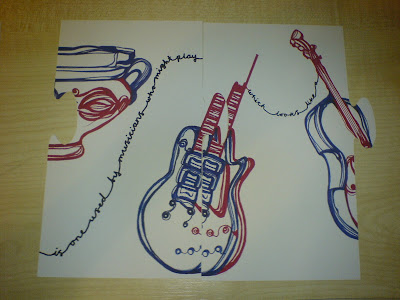1- Teapot
Object: Teapot
Place of Origin: Britain, 1951
Museum Number CIRC.18&A-1952
Location: Making Ceramics.
Room 143, Case 2, Shelf 2
An example of typical bold design and bright
colours popular during the 1950's. This particular
model of teapot was from Heal & Sons LTD,
the leading retailer of domestic style at the time.
2- Cup
Object: Cup
Place of Origin: Tonola, Mexico
Museum Number: 295-1872
Location: World Ceramics
Room 145, Case 42, Shelf 2
In 1805, Spanish women used to eat fragments from
these Bucaros de Indias believing there to be
gastronomic benefits. Not only used to flavour water,
they were also used to purify polluted water and even
detect poisoned liquids.
3 - Guitar
Object: Guitar (Les Paul)
Museum Number: S.12 - 1978
Location: Theate & Performance
room 103, case1, shelf A
There was at least one person on drugs at a gig by "The
Who" in 1976 where Pete Townshend smashed his
guitar live on stage. The lead guitarist and
songwriter for The Who, his guitar is currently on
display in the Theater & Performing Arts collection.
4- Cello
Object: Cello
Place of origin: Venice, 1700-1800
Museum Number: W.4-1950
Location: Musical Instruments
Room 40a, Case 55
In the 1750 the cello had all but replaced the bass viola.
This one belonged Jean Gérardy, a well known Belgian
cellist and accompanied him around his European
and American tour from 1890 until 1920.
5- Telephone
Object: Coral Mobile Telephone
Place of Origin: Britain
Museum Number: W.17-2003
Location: National Art Library
Room 76, Case 21
An example of the first hand portable mobile
telephone from 1985. Although hardly pocket
sized, with a very limited battery capacity,
it sparked a revolution that is still continuing to this day.
6 - Ring
Object: Jewish wedding ring
Place of Origin: Central or Eastern Europe
Museum Number: 453 - 1873
Location: Sacred Silver & Stained Glass
Room 83, Case 8A
The architectural for of this ring is actually
based on Salomon's temple; the ideal Jewish
home. The ring is supposed to symbolise the
couple's future together and the inscription
of Mazel Tov which means good luck.















